DIY Montessori Spindle Box with Recycled Cardboard Paper Rolls! (VIDEO)

The Montessori spindle box (蒙特梭利纺锤棒箱 / 蒙特梭利紡錘棒箱) is easy to make with cardboard rolls! A few years ago, I first made this for my daughter. Recently, I recently improved the DIY spindle box set up for my son!
The following photo shows what the original Montessori spindle box looks like:

Since new Montessori materials are expensive, I try to make some of my own materials with cardboard whenever possible.
Thankfully, the Montessori spindle box is easy to DIY with recycled cardboard rolls!
Try this: How to Teach Kids Basic Math for Free
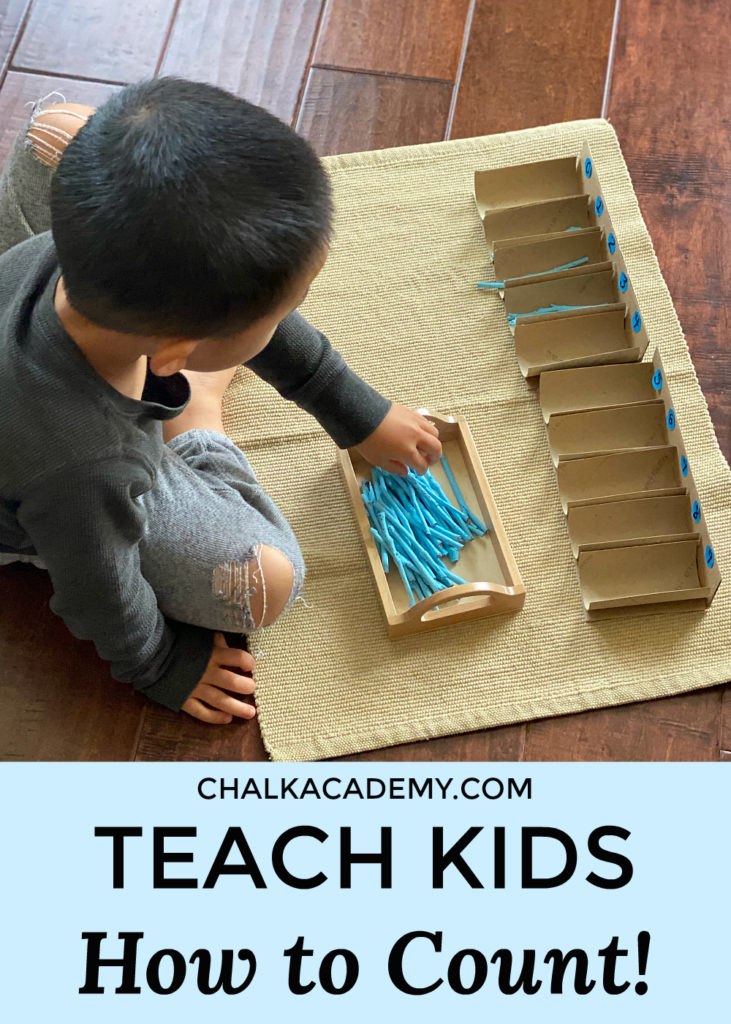
What does the Montessori spindle box teach?
The goals of the Montessori spindle box is to:
- Introduce zero (介绍零 / 介紹零 / jièshào líng)
- Learn that zero is an empty set (学习零是空集合 / 學習零是空集合 / Xuéxí líng shì kōng jíhé)
- Review numbers used in the digit system (介绍数字系统中使用到的所有符号 / 介紹數字系統中使用到的所有符號 / Jièshào shùzì xìtǒng zhōng shǐyòng dào de suǒyǒu fúhào)
- Understand number sequence (认识数字的顺序 / 認識數字的順序 / Rènshì shùzì de shùnxù)
- Cultivate order, concentration, coordination of movement, independence, and precision (培养秩序性、专注力、动作协调、独立性、精确性 / 培養秩序性、專注力、動作協調、獨立性、精確性 / Péiyǎng zhìxù xìng, zhuānzhù lì, dòngzuò xiétiáo, dúlì xìng, jīngquè xìng)
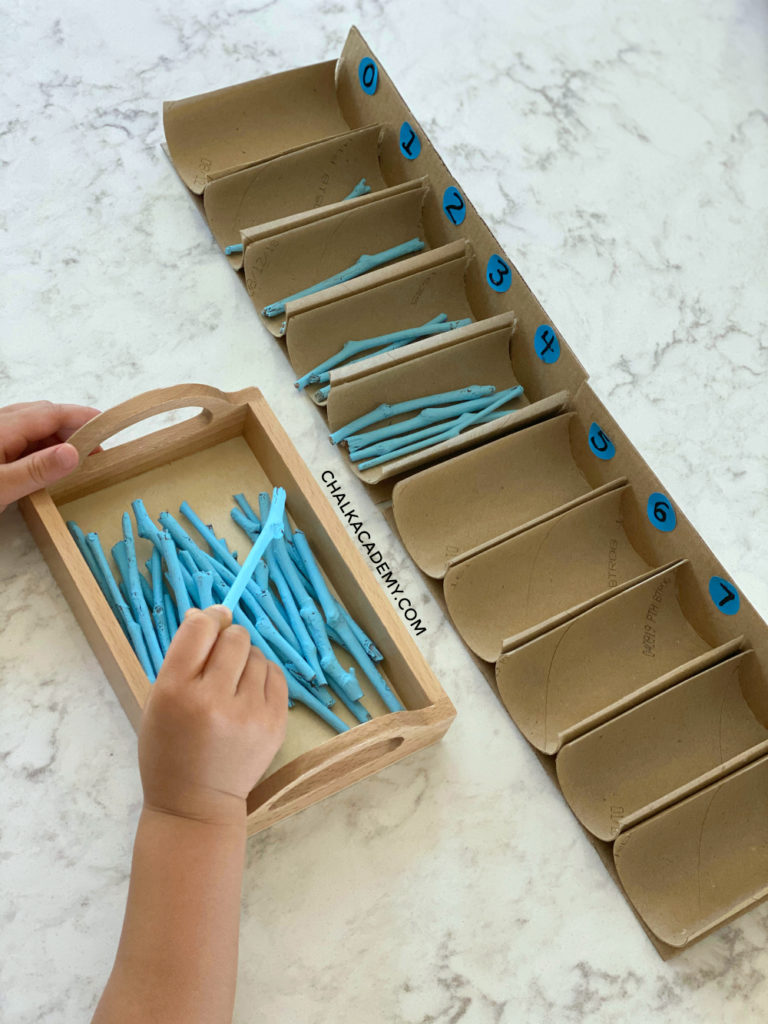
Chalk Academy is reader-supported. Some of the links are affiliate links. When you buy something through an affiliate link, we may earn a very small commission at no cost to you. Details here.
What age to present the Montessori spindle box
The spindle box is a standard math material in the 2.5-6 year old (primary) Montessori classroom.
This Montessori material is typically presented after children:
- Understand basic meaningful counting through the number rods
- Recognize symbols through Montessori sandpaper number boards
- Associate number symbols with appropriate quantity, such as the number rods with cards
At home, we do not have the space for number rods. We teach counting and one-to-one correspondence through play and regular life!
Although my daughter was past this stage when I tried it with her, the Montessori spindle boxes have been helpful for my son.
As with any milestone, every child is different and will learn these skills at their own pace!

What you need for the DIY Montessori Spindle Activity:
- 45 sticks
- Ideally exactly the same size and color so the child can focus on measuring and comparing quantity and not get distracted by the colors.
- Examples include twigs, q-tips, craft sticks, pencils, pipe cleaners,
- 5 to 10 toilet paper rolls (depending on desired DIY method)
- Box lid, basket, or tray (we have this Montessori tray with handles)
- Long cardboard pieces
- Bottom piece: 18 3/4″ length, 4 1/8″ width
- Back (for design option 2): 18 3/4″ length; at least 2″ height
- Craft glue
- Black marker or puffy (dimensional) paint
- Optional: acrylic paint (buy from Michaels or Amazon) for pop of color, dot stickers for number labels
How to Make the DIY Montessori Spindle Activity

Option 1
- Label toilet paper rolls zero to 9
- Tape or glue paper rolls together
- Mount paper rolls onto cardboard board base
Three years ago, this is the set up that I used for my daughter when she was 3 years old.
At that time, she was actually adding and subtracting in English, but I though I would try making the spindle box to teach her Chinese number symbols.
Although it took only a few minutes to make, I think my new set up (option 2 below) is better.
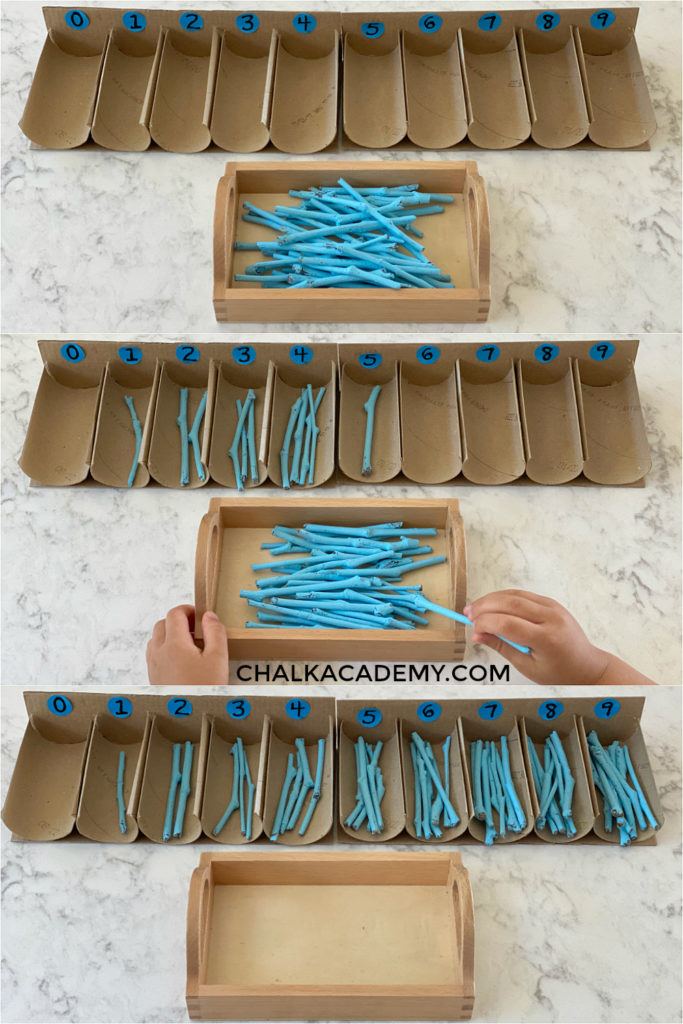
Option 2
Another way to set this up is to cut 5 toilet paper rolls in half.
Then each compartment lays flat like the official Montessori spindle box.
Since we used twigs, I decided to paint them to help them stand out against the brown cardboard rolls.
Currently, my 3-year-old son’s favorite color is blue, which led to this color choice.
Strict Montessorians may opt for red, since early math materials are typically red. However, the key is that each stick should be the exact same color, so the focus is on the quantity.
This time, I also used black puffy dimensional paint to write the numbers for extra texture.
Since most people worldwide use Arabic numerals (0, 1, 2, 3, 4, 5, 6, etc), I decided to use these symbols instead of Chinese characters for this activity.
Related: How to Use Puffy Paint to Make Tactile Chinese and Korean Letters!
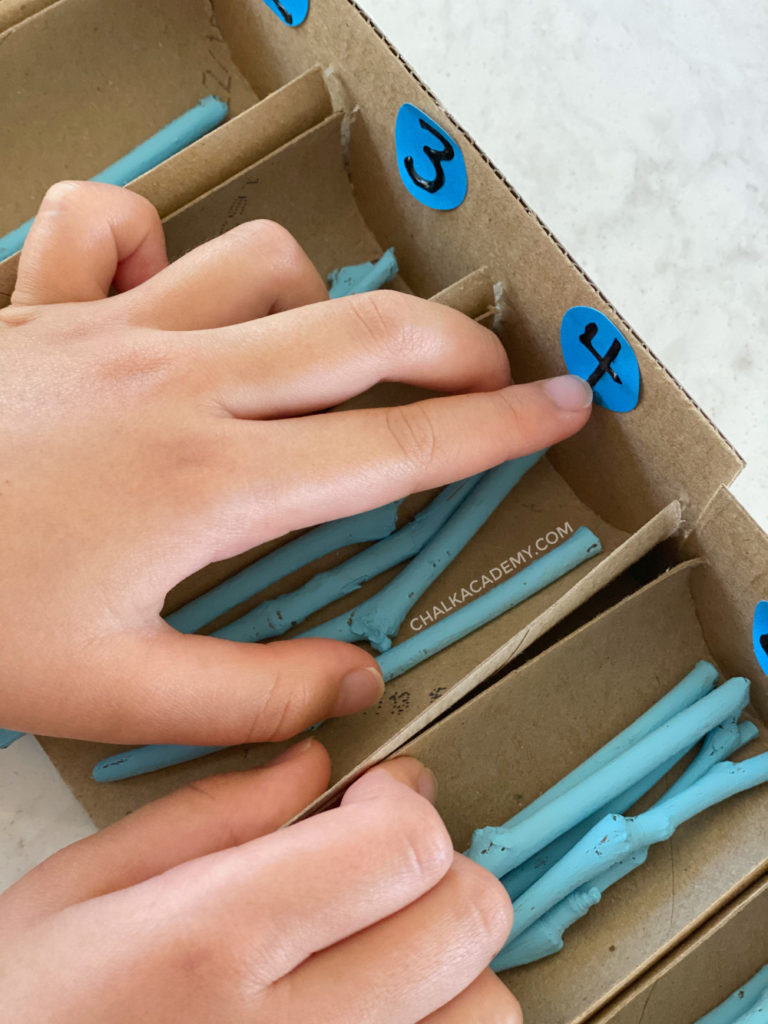
How to present the DIY Montessori spindle box
- Introduce the name of the Montessori spindle box and where it is located on the shelf.
- Remember to speak in minority languages like Chinese if that is the target home language for your family
- Carefully lay a work mat on the ground; this defines the workstation.
- Place the Montessori spindle box on it.
- Demonstrate how to use the spindle box.
- Explain that symbols represent a certain quantity of separate objects.
- Ask the child what they observe about the “zero” compartment (eg, empty, nothing)
- Starting with 1, take out the corresponding quantity of sticks and place them on the work mat.
- Re-count before placing them into the toilet paper roll.
- Grab all the sticks in one hand to feel the quantity.
- Control of error: Ensure that the tray has the exact amount of sticks needed (45). If your child has miscounted, then she will realize that he/she will have to repeat the activity is there isn’t enough or too many left at the end.
Video of Montessori spindle box lesson
This video from MyWorks Montessori demonstrates how to give a presentation to a child for the Montessori Spindle Box.
The Montessori teacher offers so many helpful teaching tips throughout the video, including other ways to create the activity!
My favorite tip is recognizing when a child is antsy and needs gross motor movement!
To encourage full body involvement, the Montessori teacher suggests placing the basket or tray of sticks far away.
For instance, if the sticks are on the opposite side of the room, the child can walk back and forth, back and forth to get the sticks!
(Of course, make sure the room is decluttered to avoid tripping hazards!)
When we can incorporate multiple senses and meet our child’s developmental needs, they are more likely to concentrate and enjoy the learning activity!
Important vocabulary in Chinese
Since my children and I have I been learning how to speak Mandarin and read Chinese characters together, I took some notes about important translations.
The following English words are translated in simplified Chinese, traditional Chinese, Hanyu Pinyin.
- 蒙特梭利数学教具 / 蒙特梭利數學教具 (Méngtè suō lì shùxué jiàojù / Montessori math material)
- 纺锤棒箱 / 紡錘棒箱 (Fǎngchuí bàng xiāng / Spindle box)
- 号 / Hào (Number)
- 零 (líng / 0)
- 一 (yī / 1)
- 二 (èr / 2)
- 三 (sān / 3)
- 四 (sì / 4)
- 五 (wǔ / 5)
- 六 (liù / 6)
- 七 (qī / 7)
- 八 (bā/ 8)
- 九 (jiǔ / 9)
- 这是什么号码? / 這是什麼號碼 (Zhè shì shénme hàomǎ? / What number is this?)
- 这个数字怎么说?(Zhège shùzì zěnme shuō? / What does this number say?)
- 你有几根棍子 / 你有幾根棍子?( Nǐ yǒu jǐ gēn gùnzi? / How many sticks do you have?)
- 我们来数数 / 我們來數數! ( Wǒmen lái shù shù! / Let’s count!)
- 你能放三支木棍在数字3旁边吗? Nǐ néng fàng sān zhī mù gùn zài shùzì 3 pángbiān ma? / Can you put three sticks next to the number 3?
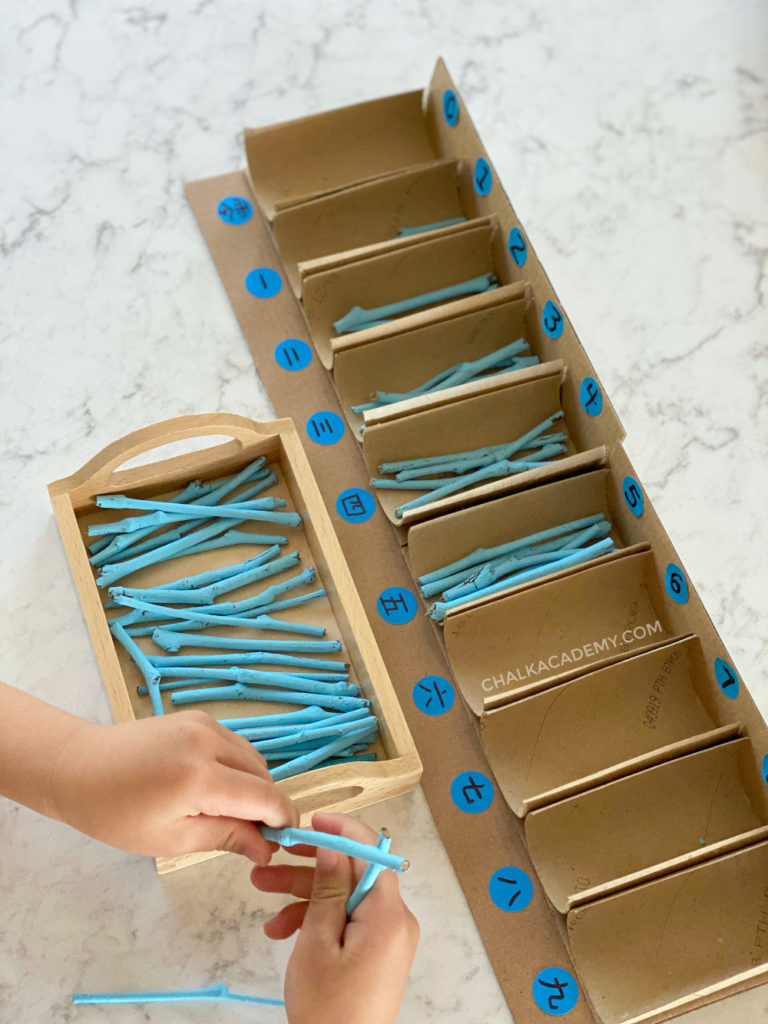
Bilingual Montessori Spindle Box example
We ended up adding Chinese numbers to our DIY Spindle box so that my son could compare the 2 different number systems.
I just glued a larger piece of cardboard under the box so there would be enough room to add Chinese number dot stickers.

Have you made a Montessori spindle box or did you end up buying one?
If you try this activity, please let us know in the comments below! What age(s) are your kid(s), and how did it go? We’d love to hear about your learning experience!
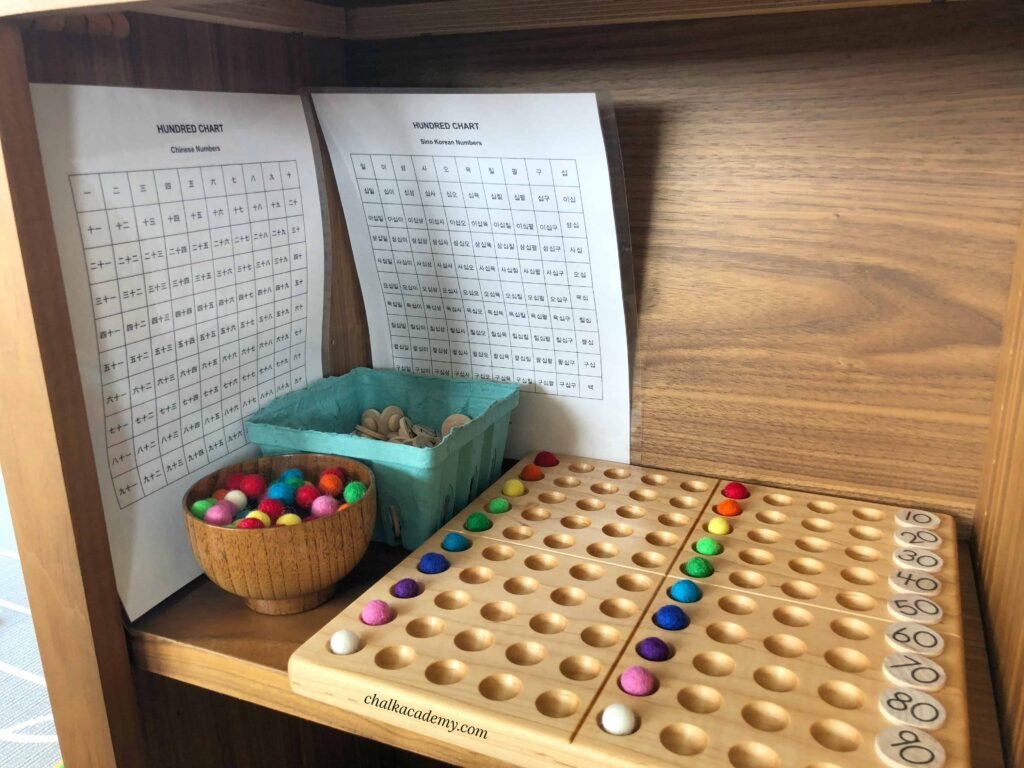
More Montessori math resources for kids
- 10+ Ways to Use a Wooden Hundred Board
- 10+ Ways to Use a Montessori Hundred Chart
- Montessori Multiplication and Division Boards
- Montessori Pythagoras Board and Bilingual Multiplication Table (English and Chinese)
- Math Story Books 数学帮帮忙 (Bilingual Simplified Chinese and English)
Hi Betty, thanks for the wonderful post. It was a fun exercise for my 4 year old son for him to learn mandarin numbers. He knows the Arabic numbers but still learning mandarin. I combined two of your ideas into one! Your pipe cleaner numbers and the spindle box made up of toilet paper rolls without the numbers (which we used the pipe cleaner numbers for) 😁 I wish I can upload a photo
Hi Natalie! Thanks so much for sharing – that sounds brilliant! So glad your son had fun. Feel free to email the photo, I’d love to check it out! [email protected] 🙂
Hi Betty! Thank you sharing your experiences and great resources! I am planning on making an “Option 2” spindle box. I am considering using a box “corner” to place the spindles and putting the Arabic numbers on the vertical surface and Chinese numbers on the flat surface. I am wondering if it would be too many symbols for a little one. Would love to hear your thoughts. Thanks!
Hi, I am a Montessori teacher and noticed that you did not get an answer so I thought I’d chime in. I think it would be fine. You may want to just use one or the other language/symbol for the first presentations, and then bring the other language in later, UNLESS the child asks about it. Then go ahead and use both all the time. Somehow, children can tell the difference between the two languages and will make the correct associations. Would love to hear how this turns out for you.
Hi Carmel, thank you for helping with your expertise! That is what we ended up doing – started with 0123456789 for the initial presentation and later added the Chinese symbols.
Hi Marcela, thanks for your question. I just got a chance to add a photo of the updated bilingual spindle box toward the end of the post. We’ve also introduced each number symbol system through other ways detailed in this post about Learning How to Count in Chinese and English. Hope this helps! 🙂